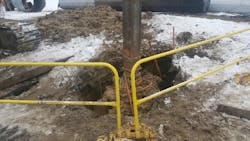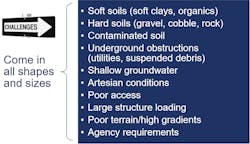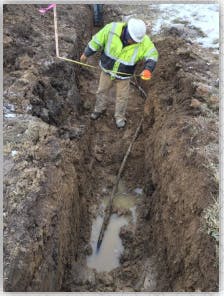Transmission Foundation Engineers Probe Underground Dangers First
Major transmission lines commonly cost hundreds of millions of dollars. Stakes are high. Deadlines are tight, environmental issues can be sticky. On large transmission structures, one of the critical issues is effective foundation design and construction. Lack of preparation and attention to detail on foundations can substantially delay or even derail a major transmission project.
Accurate information is the key to any successful engineering design, and transmission foundations are no different. If power delivery projects are analyzed early from a geotechnical point of view, it can make life easier during construction and save a ton of money on foundation material and labor costs. However, this point of view is often not the norm. Why is that?
Most power delivery engineers are electrically oriented. Even if they have some structural background, much of the early structural focus is typically on the procurement of the steel structures. Many forget that on high-voltage transmission projects, foundation (below-grade) costs can potentially equal steel and conductor (above-grade) costs. Geotech, as it is known, is something done early and then forgotten. The widespread practice is to say, “We’ll go get a few soil borings,” and then let them collect dust on someone’s desk. Moreover, the common rule of thumb is one boring at dead ends and one boring per mile of transmission line in between. Yet, depending on span lengths, there are several foundations per mile, and no guarantee that the soils beneath the pole foundation sites aren’t varied.
A typical price for a reasonable depth soil boring is US$1,200 to US$1,500 to cover drilling, sampling, minimal lab testing and a report. This is a small price to pay compared with the typical foundation price tag of US$500 to US$700 per cu yd of concrete, plus lost time and redesign fees if unforeseen conditions are uncovered. For high voltage projects, it doesn’t pay to skip drilling a boring for every foundation. This only leads to over-designed foundations or bad assumptions. Throw out the rule of thumb that doesn’t apply to larger, modern monopole transmission lines carrying multiple circuits with large bundled conductors.
Foundation Challenges Come in All Shapes and Sizes
From soft soils to rock to old, buried utility lines to environmental compliance requirements, underground conditions can have major impacts on transmission foundation construction. Here are some common situations:
Soft and loose soils – This category includes soft clays, silts and organic materials such as marshland soils. Soft soils, which can cause large deflections and settlement, dictate how deep a foundation must be designed and installed to support the controlling load on the structure. Since there is little to no end bearing, foundations must be designed for skin friction only, leading to deeper foundation designs. Soft clays and loose sands, especially when parlayed with shallow ground water, can indicate the need for casing or drilling slurry.
Hard soils – Gravel, cobble and rock often require specialized drilling techniques. Constructability should be a major concern during the design process. Is the rock weathered enough to drill through with a rock auger or will it require rock core barrel methods? Is the gravel or cobble dense enough to allow for driven or vibratory installation methods? If vibratory methods are being considered, will any suspended boulders or rock layers prevent foundations from being installed to their design embedment? Is the rock so hard that it will require blasting and the noise and vibration monitoring requirements that go along with it? These are all questions that need to be answered during design.
Underground obstructions and utilities – Some soils, especially near rivers and streams, can carry suspended logs and debris that can cause foundation installation issues. Similarly, abandoned or active underground utilities are also discovered. For buried utilities, history and local knowledge can be your friend. Many times, others have drilled there before.
As a first step, engineers should attempt to obtain old-soil boring and utility location information that may be available, whether on a zip drive or on a microfilm that hasn’t seen the light of day in decades. There is no such thing as too much survey or geotechnical data. If sufficient information to support design does not exist, engineers must then develop a comprehensive subsurface investigation and survey program to properly characterize soils and to properly identify underground obstructions.
Underground utilities often carry with them utility easements that have strict criteria for building within or crossing the easements. Not only are utilities concerned with allowing new structures within the easements, but they also tend to be worried about future maintenance needs and overhead clearance. When dealing with underground utilities, it is much cheaper to coordinate early and adjust the route or move the obstructing utility. The alternative of hitting an active pipe or line during construction isn’t very appealing, as it can shut down a project and cause a financial hit because of the need for specialty contractors, idle time, additional materials and outage reimbursements. Also, when an underground utility is hit, the project is then often at the mercy of the repair contractor’s schedule.
In congested areas where underground utilities are a major concern, there are several enhanced locate methods that can be used besides the status quo, free-state locate service. These can include ground-penetrating radar, electromagnetic conductivity, frequency locators, magnetometers or cable locators. Even after the obstructing or adjacent utilities are located using one of the methods cited above, it is still good practice to get a visual on the obstructing utility via hand digging or through the use of a vacuum truck.
Contaminated soil – If polluted soils are not sniffed out early, it can put the brakes on major power delivery projects. It can be heavy metal residue or old fuel tanks that might have been leaking for 20 years. Once uncovered, many more people develop an interest in the project suddenly.
One project crossed a shuttered automobile plant that was classified as a RCRA (Resource Conservation and Recovery Act) site. The owners planned to redevelop the site. Due diligence was carried out at every proposed structure location and on every soil boring hole, resulting in the discovery of various heavy metals, old paint and solvents and various other contaminants. In this case, local and state environmental permitting agencies only permitted the ground to be punctured in structure locations. Every particle of disturbed soil and every drop of water had to be removed, contained, manifested and hauled to an approved landfill with very specific storage capabilities.
Groundwater – Groundwater levels at a structure location have a significant impact on foundation installation techniques. Shallow groundwater, highly variable groundwater and even an artesian head can present problems, thus requiring different drilling methodologies such as the use of casing or special drilling fluids/muds to prevent cave-ins. In saturated clays and silts, shallow groundwater can also cause frost heave in cold climates. Like the identification of underground obstructions, it is also important to delineate wetlands at the site or along the project route. If a pole can be moved 10 ft out of a wetland, avoiding 40 hours of permitting hassle, it’s well worth the move.
Poor access – Engineers must consider access for construction, especially for heavy equipment and projects requiring large amounts of concrete. A design is only good if it can be built. Contractors are improving at drilling in tight spaces, but if a rig can’t gain access, the foundation can’t be installed.
These locations can be in swamps, highlands, river crossings and mountains. Access is also a consideration for ongoing maintenance needs that follow construction. Will the structures be accessible by foot patrol or will aerial patrols be needed? Poles constructed in a flood zone can be installed when the soil is dry and access is available, but when the floodwaters rise during the next spring, the same structure locations can be flooded and can become a maintenance access issue. Additionally, the engineer needs to understand state and local access regulations. For example, local governments often shut down roads in the spring to prevent damage from large trucks.
Construction Bidding: Learn the Unit Prices
Complete information is necessary to accurately bid transmission foundation construction. Leave no stone unturned. Foundation design, because of unknown underground conditions, is the contractor’s biggest opportunity for change orders, which the owner and engineer want to avoid at all cost. Bad information results in poor design and inaccurate construction bids.
Certain projects and locations, such as swamps, mountains or river crossings, require a lot of extra coordination and design. Soil borings are necessary to accurately predict the method of foundation construction. In areas requiring special foundation considerations, don’t be afraid to split a subproject out of the main project. It must be handled carefully. Share information with the owner and the contractor. There is no use in withholding information; it can only hurt the project.
Finally, when gathering foundation construction bids, require unit prices and unit adjustment prices during the bidding phase. Establish unit adjustment prices when it’s still in a competitive bid situation, rather than attempting to negotiate during construction, when the contractor holds all leverage. How much will a drilled pier installation cost if unfavorable conditions are encountered? How much will the casing that is now needed cost? What is the price per yard for driven pile?
Conclusion
If an owner utility is paying millions of dollars to construct a transmission line or substation, thorough and accurate subsurface information can result in significant cost savings and save more than a few headaches.
About the Author
Lucas Karels
Lucas Karels of the Minneapolis office of Stanley Consultants has 12 years of project management and structural engineering experience and specializes in above-grade and below-grade transmission and substation design. Karels is a licensed professional engineer in 10 states, and a published author and speaker on transmission design and project management.



